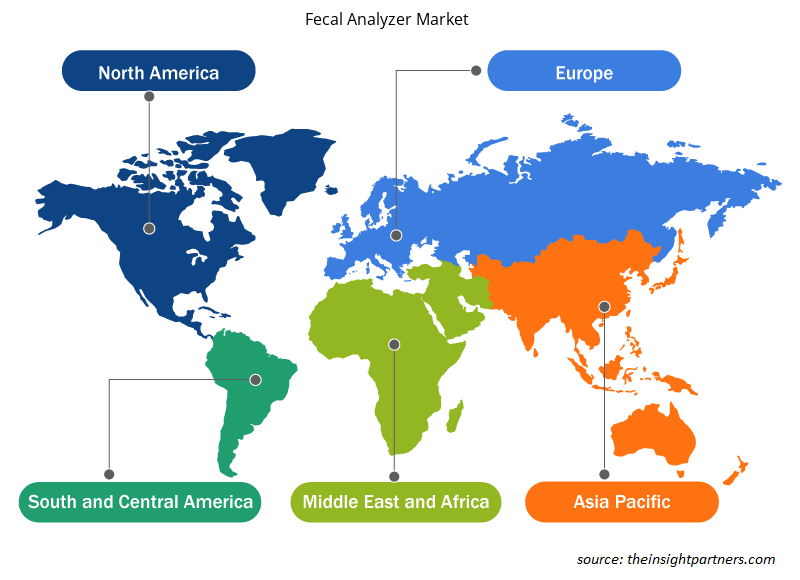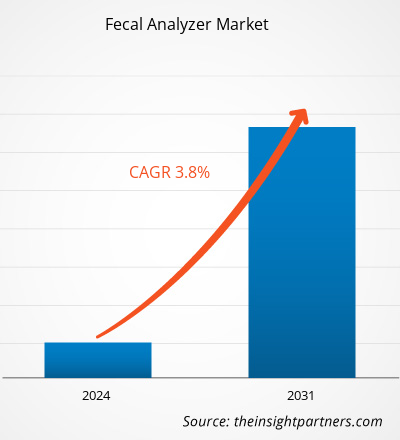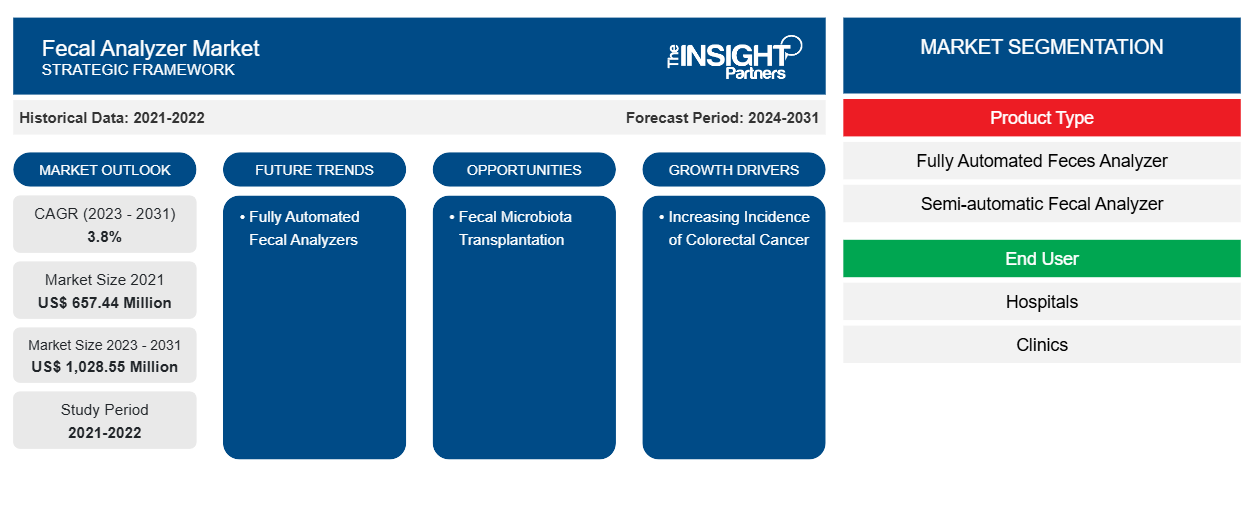Se estimó que el mercado de analizadores fecales sería de US$ 657,44 millones en 2021 y de US$ xx millones en 2023. Se espera que alcance los US$ 1.028,55 millones para 2031 y registre una CAGR del 3,8% hasta 2031. El desarrollo de analizadores de punto de atención, la integración de las pruebas de analizadores fecales con la consulta de telesalud y el desarrollo de analizadores fecales asequibles probablemente seguirán siendo tendencias clave del mercado de analizadores fecales.
Análisis del mercado de analizadores fecales
Se espera que la creciente incidencia del cáncer colorrectal impulse el crecimiento del mercado de analizadores fecales. El cáncer colorrectal también se encuentra entre los tipos de cáncer más crónicos. Los avances en la tecnología médica han llevado a la introducción de analizadores fecales que ayudan en el diagnóstico temprano del cáncer colorrectal. El cáncer de colon o colorrectal es uno de los tipos de cáncer más comunes . Según los datos de GLOBOCAN 2022, es el tercer cáncer más comúnmente diagnosticado en el mundo. Según las estimaciones de Globocan, hubo 1.926.425 casos de cáncer colorrectal en ambos sexos en 2022.
De manera similar, la Organización Mundial del Cáncer estimó que habrá alrededor de 106.590 casos nuevos de cáncer de colon (54.210 en hombres y 52.380 en mujeres) y alrededor de 46.220 casos nuevos de cáncer de recto en 2024.
Descripción general del mercado de analizadores fecales
El mercado mundial de analizadores fecales está segmentado por región en América del Norte, Europa, Asia Pacífico, Oriente Medio y África, y América del Sur y Central. Se espera que el mercado crezca en esta región debido a factores como la incidencia del cáncer colorrectal y la implementación de programas de detección, el aumento de la población geriátrica y los avances tecnológicos en dispositivos de atención médica que impulsan el crecimiento del mercado. Sin embargo, los desafíos relacionados con el análisis y el manejo de los analizadores fecales obstaculizan el crecimiento del mercado.
Personalice este informe según sus necesidades
Obtendrá personalización en cualquier informe, sin cargo, incluidas partes de este informe o análisis a nivel de país, paquete de datos de Excel, así como también grandes ofertas y descuentos para empresas emergentes y universidades.
- Obtenga las principales tendencias clave del mercado de este informe.Esta muestra GRATUITA incluirá análisis de datos, desde tendencias del mercado hasta estimaciones y pronósticos.
Factores impulsores y oportunidades del mercado de analizadores fecales
Aumento de la población geriátrica favorecerá al mercado.
Las personas mayores son más propensas a sufrir enfermedades gastrointestinales como la enfermedad de Crohn, el cáncer colorrectal y el síndrome del intestino irritable (SII). Después del cáncer colorrectal, el SII es una enfermedad que se diagnostica con frecuencia entre las personas mayores. Entre el 10 y el 20 % de las personas mayores del mundo tienen síntomas de SII. Según las estadísticas de las Perspectivas de población mundial para 2022 de las Naciones Unidas (ONU), había alrededor de 771 millones de personas mayores de 65 años en todo el mundo, lo que representa casi el 10 % de la población mundial y se proyecta que alcance el 16 % en 2050.Crohn's disease, colorectal cancer, and irritable bowel syndrome (IBS). After colorectal cancer, IBS is a commonly diagnosed disease among older people. ~10–20% of elderly people in the world are diagnosed with the symptoms of IBS. According to statistics from the United Nations (UN) Global Population Prospects for 2022, there were around 771 million people aged 65+ years across the globe, accounting for almost 10% of the world’s population and is projected to reach 16% in 2050.
Trasplante de microbiota fecal: una oportunidad en el mercado de los analizadores fecalesMicrobiota Transplantation – An Opportunity in Fecal Analyzer Market
El trasplante de microbiota fecal (FMT) es el proceso de transferencia de heces de un donante sano a un paciente que vive con una infección por Clostridium difficile. Los avances en la tecnología médica han permitido un diagnóstico eficiente del cáncer colorrectal y el síndrome del intestino irritable a través del análisis fecal. Estos avances también han ayudado a realizar investigaciones relacionadas con el FMT, lo que ha fomentado el lanzamiento de diferentes analizadores fecales. Sin embargo, el FMT no se realiza de forma rutinaria para indicaciones distintas a la colitis recurrente por C. difficile, ya que se requiere más investigación para determinar el trasplante fecal para otras afecciones médicas. Los avances en el FMT generarían una mayor demanda de analizadores fecales en los próximos años. Además, es probable que la creciente conciencia sobre el FMT en las regiones en desarrollo como Asia Pacífico y África, con una mayor incidencia de enfermedades gastrointestinales que las regiones desarrolladas, brinde oportunidades de crecimiento vitales para los actores del mercado de analizadores fecales.microbiota transplantation (FMT) is the processes of transferring stool from a healthy donor to a patient living with Clostridium difficile infection. Advancements in colorectal cancer and IBS through fecal analysis. These developments have also helped conduct research related to FMT, thereby encouraging the launch of different fecal analyzers. However, FMT is not routinely performed for indications other than recurrent C. difficile colitis, as more research is required for determining the fecal transplantation for other medical conditions. Developments in FMT would generate greater demand for fecal analyzers in the coming years. Further, mounting awareness regarding FMT in developing regions such as Asia Pacific and Africa, with a greater incidence of gastrointestinal diseases than developed regions, is likely to serve vital growth opportunities to the fecal analyzer market players.
Análisis de segmentación del informe de mercado de analizadores fecales
Los segmentos clave que contribuyeron a la derivación del análisis del mercado de analizadores fecales son los servicios y las aplicaciones.
- Según el tipo de producto, el mercado de analizadores fecales se segmenta en analizadores fecales totalmente automatizados y analizadores fecales semiautomáticos. El segmento de analizadores fecales totalmente automatizados tuvo la mayor participación del mercado en 2023 y se prevé que registre la CAGR más alta del mercado durante el período de pronóstico.
- Por usuario final, el mercado de analizadores fecales se ha segmentado en hospitales, clínicas y otros. El segmento de hospitales tuvo la mayor participación del mercado en 2023, y se estima que el mismo segmento registrará la CAGR más alta del mercado durante el período de pronóstico.
Análisis de la cuota de mercado de los analizadores fecales por geografía
El alcance geográfico del informe de mercado de Analizador de heces se divide principalmente en cinco regiones: América del Norte, Asia Pacífico, Europa, Medio Oriente y África, y América del Sur / América del Sur y Central.
América del Norte incluye EE. UU., Canadá y México. El mercado de América del Norte tuvo una participación significativa en el mercado global durante el año 2023. Se prevé que la demanda del mercado en la región experimente un crecimiento a un ritmo significativo durante el período de pronóstico debido a varios factores, como la alta tasa de incidencia del cáncer de colon y las crecientes iniciativas para la detección obligatoria mediante pruebas de heces, y la presencia de actores del mercado que ofrecen analizadores fecales totalmente automatizados y semiautomatizados avanzados en todos los países.
La región de Asia Pacífico es el mercado de más rápido crecimiento para los analizadores fecales a nivel mundial debido al creciente desarrollo de analizadores fecales en países como Japón y China. Las crecientes preocupaciones sobre la diarrea, el cáncer de colon y otras enfermedades y el creciente número de laboratorios de diagnóstico en la India brindan oportunidades de crecimiento para el mercado. Además, se espera que el aumento de la inversión en los sectores de biotecnología en Corea del Sur y Australia brinde oportunidades de crecimiento vitales para el mercado.
Perspectivas regionales del mercado de analizadores fecales
Los analistas de Insight Partners explicaron en detalle las tendencias y los factores regionales que influyen en el mercado de analizadores fecales durante el período de pronóstico. Esta sección también analiza los segmentos y la geografía del mercado de analizadores fecales en América del Norte, Europa, Asia Pacífico, Oriente Medio y África, y América del Sur y Central.

- Obtenga datos regionales específicos para el mercado de analizadores fecales
Alcance del informe de mercado de analizadores fecales
| Atributo del informe | Detalles |
|---|---|
| Tamaño del mercado en 2021 | US$ 657,44 millones |
| Tamaño del mercado en 2031 | US$ 1.028,55 millones |
| CAGR global (2023 - 2031) | 3,8% |
| Datos históricos | 2021-2022 |
| Período de pronóstico | 2024-2031 |
| Segmentos cubiertos | Por tipo de producto
|
| Regiones y países cubiertos | América del norte
|
| Líderes del mercado y perfiles de empresas clave |
|
Densidad de actores del mercado: comprensión de su impacto en la dinámica empresarial
El mercado de analizadores fecales está creciendo rápidamente, impulsado por la creciente demanda de los usuarios finales debido a factores como la evolución de las preferencias de los consumidores, los avances tecnológicos y una mayor conciencia de los beneficios del producto. A medida que aumenta la demanda, las empresas amplían sus ofertas, innovan para satisfacer las necesidades de los consumidores y aprovechan las tendencias emergentes, lo que impulsa aún más el crecimiento del mercado.
La densidad de actores del mercado se refiere a la distribución de las empresas o firmas que operan dentro de un mercado o industria en particular. Indica cuántos competidores (actores del mercado) están presentes en un espacio de mercado determinado en relación con su tamaño o valor total de mercado.
Las principales empresas que operan en el mercado de analizadores fecales son:
- Corporación Heska,
- AVE Ciencia y Tecnología Co.Ltd,
- Eiken Chemical Co., Ltd.,
- iClear Limitada,
- Mejorar los instrumentos médicos,
- Belson sistema médico Co., Ltd,
Descargo de responsabilidad : Las empresas enumeradas anteriormente no están clasificadas en ningún orden particular.

- Obtenga una descripción general de los principales actores clave del mercado de analizadores fecales
Noticias y desarrollos recientes del mercado de analizadores fecales
El mercado de analizadores fecales se evalúa mediante la recopilación de datos cualitativos y cuantitativos posteriores a la investigación primaria y secundaria, que incluye publicaciones corporativas importantes, datos de asociaciones y bases de datos. A continuación, se incluye una lista de los avances en el mercado de analizadores fecales y las estrategias:
- En junio de 2022, Sentinel Diagnostics, una empresa italiana, lanzó el analizador SENTiFIT 800, un sistema totalmente automatizado y de alto rendimiento para pruebas inmunoquímicas fecales (Fuente: Comunicado de prensa de la empresa)
- En septiembre de 2020, ISE SRL lanzó su nuevo analizador totalmente automatizado, compacto, confiable y versátil para evaluar trastornos metabólicos como: diabetes, panel cardíaco, deficiencias de vitaminas, función gastrointestinal (FECAL), función renal, trastornos metabólicos, admisión hospitalaria, enfermedades inflamatorias, proteínas específicas y química clínica. (Fuente: Nota de prensa de la empresa)
Informe de mercado de analizadores fecales: cobertura y resultados
El informe “Tamaño y pronóstico del mercado de analizadores fecales (2021-2031)” proporciona un análisis detallado del mercado que cubre las siguientes áreas:
- Tamaño del mercado y pronóstico a nivel global, regional y nacional para todos los segmentos clave del mercado cubiertos bajo el alcance
- Dinámica del mercado, como impulsores, restricciones y oportunidades clave
- Principales tendencias futuras
- Análisis detallado de las cinco fuerzas de Porter y PEST y FODA
- Análisis del mercado global y regional que cubre las tendencias clave del mercado, los principales actores, las regulaciones y los desarrollos recientes del mercado.
- Análisis del panorama de la industria y de la competencia que abarca la concentración del mercado, el análisis de mapas de calor, los actores destacados y los desarrollos recientes
- Perfiles detallados de empresas
- Análisis histórico (2 años), año base, pronóstico (7 años) con CAGR
- Análisis PEST y FODA
- Tamaño del mercado, valor/volumen: global, regional y nacional
- Industria y panorama competitivo
- Conjunto de datos de Excel
Informes recientes
Informes relacionados
Testimonios
Razón para comprar
- Toma de decisiones informada
- Comprensión de la dinámica del mercado
- Análisis competitivo
- Información sobre clientes
- Pronósticos del mercado
- Mitigación de riesgos
- Planificación estratégica
- Justificación de la inversión
- Identificación de mercados emergentes
- Mejora de las estrategias de marketing
- Impulso de la eficiencia operativa
- Alineación con las tendencias regulatorias























 Obtenga una muestra gratuita para - Mercado de analizadores fecales
Obtenga una muestra gratuita para - Mercado de analizadores fecales